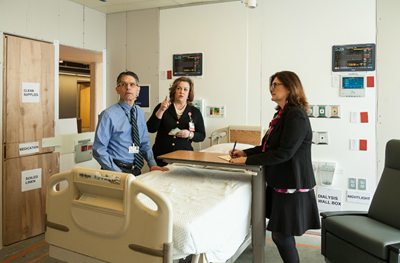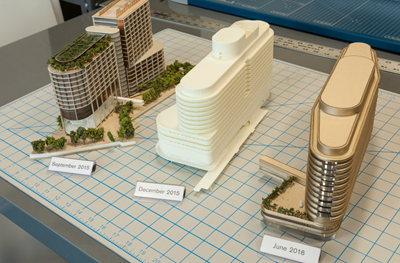
(From left) Steve Greulich, senior project manager; and Kate Newcomb-DeSanto and Kathy Gallagher, both clinical liasions at PennFIRST, discuss
possible changes in a patient's room, based on feedback.
When Lynn Schuchter, MD, chief of Hematology and Oncology, entered the 30,000-square foot mockup of an inpatient floor for the forthcoming Pavilion – Penn Medicine’s new hospital under construction across the street from HUP – she was shocked by its size. In her 29 years at Penn Medicine, Schuchter’s department has built a half-dozen clinics and offices, she said, and the largest mockup she’d seen before was a single room. “[The Pavilion mockup] was on a scale that I never, ever imagined was done,” Schuchter said.
But once Schuchter began participating in her assigned simulation – a run-through of a real-life scenario in the mockup to assess the viability of the Pavilion design – her awe turned to concern. “It was so clear,” she said, “that the spaces weren’t right.” Stepping off the elevator, Schuchter felt she entered a cold and sterile environment. There was no immediate greeter or human contact when coming off the elevators into the unit. Furthermore, teaming spaces and consult rooms for meeting with families for goals-of-care or end-of-life conversations felt segregated.
“We had hoped that with the new space this would be a feeling of healing and welcoming,” Schuchter said, “and we would have better spaces to have difficult conversations.” Like other simulation participants, Schuchter provided her feedback on the building design in a variety of ways: through Post-It notes, surveys, emails and more.
The design team carefully synthesized that feedback and responded by redrawing the entire plan.
As Penn Medicine’s largest and, at $1.5 billion, most expensive construction project to date, the Pavilion is already breaking records ahead of its planned 2021 opening. But it’s also ushering in a new way to design buildings here, one that is person-powered. Penn Medicine employees have been involved in every aspect of the Pavilion so far, from the original blueprints to the full-scale mockup to the updated design plan.
“It’s book knowledge versus applied knowledge,” said Kevin Mahoney, SVP and chief administrative officer for the Health System. “An architect can say, ‘I’ve built 100 hospitals.’ But only a nurse can say, ‘I’ve worked in a hospital and this is what it’s like at 3 o’clock in the morning.’ Having applied knowledge from our employees brought into project is really important.”
This person-powered approach started with the creation of PennFIRST, the Pavilion’s “integrated project delivery” team, which incorporates staff from all the firms involved in the project, including Penn Medicine employees, architects, designers, engineers, construction workers and more. Among the 100-person team are two Penn Medicine nurses who left the bedside to represent the voice of the clinician in the building design process. At the PennFIRST location at 3737 Market Street, Penn Medicine staff can visit mockups of Pavilion rooms and give feedback on the designs.

The Pavilion's footprint evolved over the course of the design project.
Kathy Gallagher, MS, BSN, who spent most of her 35 years at Penn Medicine as a surgical critical care nurse and nurse manager, became a clinical liaison at PennFIRST in 2015. She’s moved to new units during her time here and knows the frustration of being forced to do workarounds in old and inflexible buildings. “After you move in, you think, ‘Why would they do it this way? Why would they put that there? This doesn’t work for me,’” she said. “If you wait until it’s already designed, you can’t make some of the changes that work better for clinical staff and for patients.” Nevertheless, Gallagher and the PennFIRST team thought they had a solid plan for the Pavilion when they reviewed it on paper before the simulations.
Once the PennFIRST team settled on a building design, the group hired union contractors to construct the foam mockup in a downtown warehouse. More than 600 Penn Medicine employees toured the in-patient mockup and offered input on the design, while about 100 others including nurses, physicians, pharmacists, secretaries and more representing cardiology, neurosciences, surgery, medicine and oncology participated in four-hour simulations in the space. “People were from every angle of patient care,” Schuchter said. “Everybody wanted to be fully engaged and took the exercise very seriously.”
And so did the PennFIRST team. Three months after the first round of simulations, participants were invited back to the remodeled mockup for a second round. Along with major changes, such as an entirely new building footprint, the revised design featured more subtle tweaks that spoke directly to the concerns Schuchter and other simulation participants had raised. Two elevator cores were created to provide a more centralized location in the building. The building was angled to bring more natural light into the patient floor for staff and patients. “Off-stage” spaces were better connected to “on-stage” areas, allowing for more visibility of providers in teaming spaces and consult rooms closer to the patient. “Everybody’s voice mattered…. This was not at all hierarchical,” Schuchter said. “To hear people and go back and say, ‘It’s not right; do it again,’ at this scale, it’s pretty stunning.”
Penn Medicine employees are also working to ensure the Pavilion design keeps them – and their colleagues – in mind. Lisa Bellini, MD, vice dean for Academic Affairs, is part of a team developing well-being initiatives for clinicians throughout Penn’s campus. They’ve worked with PennFIRST on the Pavilion design to create rooms on every floor dedicated to wellness and helping clinicians recover from stressful situations and avoid burnout. These include mothers’ rooms for nursing and pumping milk, places to nap after a night shift and spaces for respite. “It’s about taking care of all the clinicians who take care of the patients,” Bellini said. “It’s just important that people understand that they’re cared about.”
Not only is the final design better for patients and clinicians, Gallagher said, but the staff felt their opinions were valued and heard. “The biggest comment, almost from everybody who came back, was, ‘Wow, you really listened to us,’” she said. “It was great for the staff to see how much the organization was invested in them.… This is a good retention plan because now they’re all excited to get over there and work!”
For her part, Gallagher said she hopes to take her future grandchildren to see the completed Pavilion one day. “It’s exciting,” she said. “How many nurses can say they helped build a hospital?”